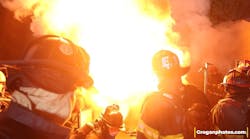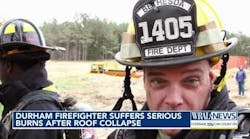The ability to learn from international firefighters is one of the pillars of Firehouse World—and this shared knowledge is particularly vital when it focuses on safety.
In his Firehouse World session “Safety in the Swedish System,” Stefan Svensson offered an overview of how safety is treated in the Swedish fire service, its roots in education and training, and how it’s implemented in operations. “The safety of my crew is my first concern,” he said, and this principle drives much of the Swedish fire service’s approach to operations.
Svensson shared that between 1936 and 2016, there have been 56 firefighter fatalities—a statistic that might seem shocking to his American counterparts, as the U.S. fire service sees more fatalities on an annual basis. Additionally, the highest percentage of Swedish fire service fatalities are trauma related (34 percent), followed by burns (27 percent) and asphyxiation (13 percent). Cardiovascular deaths result in 7 percent of their fatalities, a significant difference from the American fire service that sees approximately 50 percent of fatalities attributed to cardiovascular issues.
As it relates to safety, Svensson explained that while there are no national regulations on tactics, training and education, there are strict regulations on safety, issued by the Swedish Work Environment Authority (the equivalent of NIOSH).
Svensson detailed the various health- and safety-related risks faced by members of the Swedish fire service, and explained some of the tactics employed to mitigate these risks.
To keep responders safe during roadway incidents, firefighters block the entire road, even for a single-car incident. “People get so mad at us, but we don’t care,” he said. The key is the safety of the firefighters operating at the scene.
He highlighted the differences between European and American helmets, noting the low center of gravity and the integrated intercoms used in European helmets.
Another potential risk is falling, for example, from a roof or ladder. Svensson explained that ladders are only used for moving from point A to point B—not as a tool from which to work—and that ladders must be secured. And for roof operations, firefighters must be hooked in via a harness. Considering the number of safety requirements involved, Swedish firefighters tend to avoid these operations, opting instead to work from a bucket.
Perhaps the most obvious risk associated with firefighting is heat stress related to radiation, convection, conduction, burn injuries and hyperthermia. Svensson shared that in order to counter the effects of heat and physical stress, firefighters are restricted to a certain number of runs they can perform each day and each week, forcing them to take periods of rest.
Svensson stressed that breathing apparatus is the most important protection firefighters have and, as such, the Swedish fire service has strong regulations related to its use. Further, “it’s never a question,” he said; firefighters are expected to use it. Specifically, the breathing apparatus procedures for structural firefighting are as follows:
- Medical examination (every second year or annually)
- Physical testing (annually)
- 56 hours basic education/training
- 2 hot + 2 cold training sessions required each year
Additionally, the structural firefighting minimum crew size is one officer, one pump operator, one senior firefighter (at the door), two firefighters on the inside with a hoseline, radio and full PPE.
When it comes to the tactic VEIS—vent, enter, isolate, search—in Sweden, firefighters are simply not allowed to perform an interior search singlehandedly, without a hose and without a radio. Svensson posed the question “remove the victim or remove the hazard?” contending that he would often opt for removing the hazard, as that often solves the victim’s problem—and that keeps firefighters safer. But he acknowledged that there are times that saving the victim can’t wait even the few minutes it might take to remove the hazard, and operations are adjusted accordingly.
The Swedish fire service also has strong physical fitness standards involving medical evaluations and treadmill tests, Svensson said, and if you can’t pass these tests, you can’t perform structural firefighting.
Psychological stress is a topic that has received more attention in recent years in the American fire service. In Sweden, Svensson explained, they require responders to meet with someone after difficult calls, giving them the opportunity to talk about the experience. Firefighters can meet for 30 minutes or 5 hours—whatever they need to get help, he said.
Svensson also shared a video about the Skellefteå Model, an approach to keeping Swedish firefighters protected from toxic particles. Stefan Magnusson, a firefighter and the health and safety representative for the Skellefteå Fire & Rescue Service in Sweden, spoke on the topic at Firehouse World as well.






